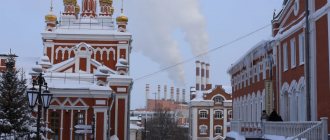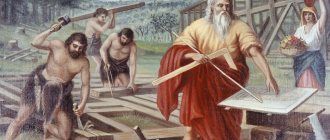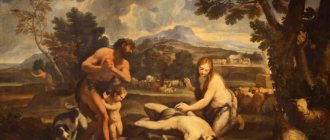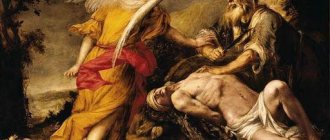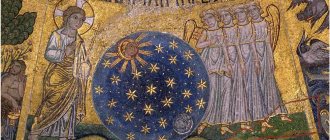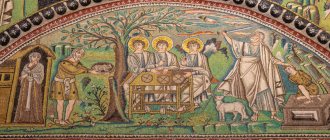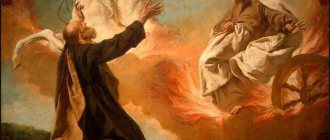This is the well-known story about Noah and his ark, the secret of salvation, which is hidden in the Bible. The history of humanity from Adam to Noah, which, unfortunately, ended tragically for most people.
So who is Noah? What did he do to deserve salvation? What qualities did he have? Is he special or not?
We can find the answer to all these questions by studying the Bible and looking at the whole picture. The Lord, as an artist, draws on the canvas of time his plan - his plan for man.
God's Plan
The Lord created the first man in His image and likeness. The Creator gave Adam possession of the whole earth to rule it, clothed him with God's glory and placed him in the most beautiful place, “Eden” (Genesis 1:26).
But soon, disobedience to God led man to sin, expulsion from the garden and loss of close fellowship with God. Humanity subsequently became fruitful and multiplied no longer with the righteousness of God, but with a sinful nature that resisted the ways of the Creator. Disobedience grew from generation to generation.
Man began to resemble the Creator less and less. Everyone had free will in thoughts and actions, choosing their own path.
But without God’s guidance, everyone’s life is doomed to a pitiful semblance of a “happy” life. Position, status, finances, fame, appreciation from others, power - all this does not give and does not guarantee a person real happiness, peace, tranquility and, even more so, salvation.
The water stood on the ground for a whole year
It is believed that the water did not leave the land for a whole year. How did Noah live all this time? Imprisoned in the ark, unable to even see the sky, Noah had to endure great tribulation. He also regretted the dying people.
This is what Noah's Ark supposedly looked like
Only after 150 days did the water begin to recede. Another month later, Noah felt that the movement of the ark had stopped. Scripture names the place where the ark stopped: Mount Ararat on the border of what is now Armenia and Turkey.
For another two months, Noah did not dare to leave the ark, awaiting God’s command. His faith and trust in God was absolute. Apparently, they were still strengthened during the year spent without light, among the waves, in one hope in the Lord. Only after a direct instruction from the Lord did Noah come to earth. His wife, sons and their wives came out with him.
Biblical story of Noah
In the 182nd year of his life, Lamech, Noah's father, gave birth to a son. They gave him a name meaning “comfort” (Gen. 5:29). Nothing is said about Noah's upbringing, but it can be assumed that he grew up in reverence and respect for the God about whom his father spoke.
This is evidenced by the fact that Noah communicated with the Creator. The Lord warned him about what He wanted to do, how and what size to build the ark, etc. Scripture characterizes Noah as a righteous man and blameless in his generation, who walked with God (Gen. 6:9).
He was obedient to the word of the Lord, not only in the construction of the ark, but also in life, which pleased God. Noah’s amazing fortitude, courage and firmness speak of his trust in God, love and respect for the Creator. Using common sense, Noah did the right thing - this does not mean that he did not make mistakes, but the life he lived speaks of a desire to please God with all his might.
What surrounded Noah? The absolute opposite. People living at that time did not care to have God in their minds, they were disobedient to His commandments, self-willed, evil, arrogant, and lacked moral purity (Gen. 6:5-7).
Noah - Noah, the progenitor of humanity
Table of contents
Birth of Noach.
Noah - the righteous in the generation of the Flood ↓ World Flood ↓
World after the Flood ↓
Bnei Noach - descendants of Noach ↓
Did you know that Noah had two names? Do you know the details of his birth? Biography of the righteous man and builder of the ark
.
Birth of Noach. Noah - the righteous in the generation of the Flood [↑]
Noah ben Lemech (נח; 1056-2006 /2704-1754 BC/) - an outstanding righteous man, one of the founders of humanity.
The tenth generation from Adam is the great-grandson of Hanoch and the grandson of Methuselah. His mother Eshmoah, daughter of Elishua, son of Hanoch, married Lemech in 1055 /2705 BC/ ( Sefer ayashar; Seder adorot
).
Born in 1056, when his father Lemech was 182 years old ( Bereishit 5:28
).
He was born without a foreskin - “circumcised” ( Avot derabi Nathan 2:5; Shocher tov 9
).
Methuselah called him Noah, and his father gave him the additional name Menachem, saying: “This one will bring us comfort ( yenakhmeinu
)» (
Bereshit 5:29; Sefer ayashar; Yalkut Shimoni, Bereshit 42
).
He studied with his grandfather Methuselah, who was the ruler of all mankind ( Seder Hadorot
).
During that period of history, many inhabitants of the earth perverted their ways, ceasing to follow the instructions of the wise Methuselah. According to the Torah, moral decay began with the fact that “the sons of rulers...took for themselves women, all whom they chose” ( Genesis 6:2, Rashi
).
“Any breach begins with the leaders of a generation,” and then the sons of kings and nobles began to take other people’s wives by force. They also committed fornication with men and with livestock ( Bereishit Rabbah 26:5, Maarzo
) - the wicked “crossed livestock with wild animals and animals with livestock, and all animals with people, and people with all animals” (
Sanhedrin 108a
).
Many women in that generation walked around exposing their flesh and making up their eyes, like harlots, and men were defiled by all kinds of debauchery - openly and right on the street, having sex even with their mothers and daughters ( Pirkei derabi Eliezer 22
).
And it was those who were called upon to monitor the observance of the law who were especially outrageous - and there was no one to stop them ( Ramban, Bereshit 6:2
).
For many years, Noah lived in solitude, trying to protect himself from the influence of the wicked of his generation. He intently studied the books of Adam and Hanoch in order to learn the ways of serving the Creator ( Zohar 1, 58b
), - and the Torah says that “Noah found favor in the eyes of the Lord” (
Bereishit 6:8
).
IN 1536
year /2224 BC/ Noah was awarded a prophecy: the Almighty revealed to him that if humanity does not repent of its crimes and does not return to a righteous lifestyle, then after 120 years it will be destroyed by the waters of the flood (
Genesis 6:3 , Rashi; Sefer ayashar
).
After all, the Creator “never carries out judgment in the world until He announces it and notifies the defendants,” as He “notified the generation of the flood through Noah” ( Zohar 1, 58a
).
Day after day, Noah and his grandfather Methuselah, who also received a similar prophecy, called on their contemporaries to repentance, but they were not listened to ( Sefer ayashar
).
Noah said: “Repent! Otherwise, the Creator will bring a flood on you, and your bodies will float on the waters like skins!” ( Sanhedrin 108a, Rashi
).
He spoke to crowds of people, but one day he felt that embittered listeners were planning to kill him. And then he fled in fear from populated areas ( Seder Hadorot
).
That same year, the Almighty commanded Noach to build a large ship - an ark, on which he could be saved on the day of the global catastrophe ( Bereishit 6:14, Rashi; Seder Hadorot
).
Noah immediately planted seedlings of cedar trees of the type indicated to him ( gopher
), so that when they grew, he could build from them the body of the ark, which, according to the command of the Almighty, was supposed to reach three hundred cubits (approx. 150 m) in length and fifty (approx. . 25 m.) - in height (
Bereshit 6:14-15; Bereshit Rabba 30:7, Radal; Otsar Ishei HaTanach, Noach
).
IN 1554
year /2206 BC/, at the age of 498 years, Noah, following the direct command of the Almighty, married Naama, the daughter of the righteous Hanoch and the sister of Methuselah, who by that time was already 580 years old (
Sefer Ayashar; Seder Adorot
).
According to another version, Naama came from the line of Cain ( Bereishit Rabbah 23:3; Rashi, Bereshit 4:22
).
IN 1556
year /2204 BC/ Noach had his first-born son Yephet, in 1557 a second son, Ham, and a year later, a third son, Shem (
Bereishit 5:32, Rashi; Sanhedrin 69b; Seder Hadorot
).
When the mighty cedars grew, people began to ask Noah why he planted them. And he explained that the Almighty intends to destroy the earth with a flood, and in order to be saved, he needs to make an ark from these cedars. But everyone laughed at him ( Tanhuma, Noach 5
).
IN 1604
year /2156 BC/ Noach began to build the body of the ark (
Pirkei derabi Eliezer 23
).
IN 1651
year /2109 BC/ Noach’s father, Lemekh, died, and in the same year the last righteous people of his generation passed away. Of all those who served the Creator, only the family of Noah and his grandfather Methuselah remained.
That same year, Noach began finishing the ark, a work that continued for five years.
He again and again warned people about the impending catastrophe, but they did not listen to him and said: “If a flood and pestilence should fall, it would only be on this man’s family.” After all, his father Lemekh and many other decent people died in a short time. Noach was dishonored and dishonored in every possible way - in that generation he was called bizaya sava
(“a disgraced old man”) (
Bereishit Rabbah 30:7; Sanhedrin 108b
).
At the beginning 1656
/2104 BC/, when work on the ark was finally completed, Noah took wives for his sons - the three daughters of Eliakim, the son of Methuselah (
Sefer ayashar; Seder adorot
).
Shortly after the weddings, on Cheshvan 11, 1656
, Methuselah died, and for seven days Noach and his family were in mourning.
But even on the day of Methuselah’s death, Noah was again awarded a prophecy, and the Almighty said to him: “Enter you and all your family into the ark, for I have seen you righteous before Me in this generation” ( Genesis 7:1; Seder Hadorot
).
The Talmud states that although the generation of the flood transgressed every conceivable prohibition, their sentence was sealed precisely for robbery ( Sanhedrin 108a
).
In the Torah itself, the main crime of this generation is called hamas
(“robbery”; see Bereshit 6:13), and commentators explain that the concept of
hamas
also includes petty thefts for which it is impossible to go to court to restore justice.
It was this type of crime that was especially common in the generation before the flood: this “robbery” ( hamas
) was committed openly, in the light of day, with general consent (
Bereishit Rabbah 31:5, Nekhmad Lemar'e
).
By definition p. Ovadi Seforno, robbery took on a total character, and people stopped seeing evil in it: after all, “everyone stole from each other” ( Seforno, Bereshit 6:13
).
And the author of the book Ohr Achaim, Rabbi Chaim ibn Athar, adds: “In the generation of the flood, everyone stole what they could, ... and if the situation was such that it was impossible to rob or steal, they resorted to fraud and deception” ( Or Achaim, Bereshit 6 :13
).
However, according to a broader definition, the concept of Hamas
includes not only robbery, but also “all kinds of abominations” (
Maarzo, Bereshit Rabbah 31:1
) - including idolatry, bloodshed and debauchery.
According to the midrashic testimony, the inhabitants of the earth are literally “mired in debauchery,” and “depravity ( znut
) inevitably leads civilization to universal destruction” (
Bereshit Rabbah 26:5, 31:6
).
And yet, “the generation of the flood was not wiped out from the face of the earth until they began to draw up marriage contracts between men and between people and livestock” ( Bereishit Rabbah 26:5; Rashi, Chulin 23a, “Ki Ishchit”
).
And since the people of that generation not only succumbed to their passions from time to time, but debauchery acquired the force of law among them, repentance became practically impossible ( Maarzo on Bereshit Rabbah 26:5
).
The Talmud says that “the sentence was passed on Noah also,” because since the world is judged by the majority, and most of his contemporaries were wicked, the sentence applied to all humanity ( Sanhedrin 108a, Yad Rama and Maarsha
), - but he and his family were pardoned (
Sanhedrin 108a, Yad Rama and Maarsha
).
And although the Torah says: “Noah is a righteous man” ( Genesis 6:9
) and “I saw you righteous in this generation” (
ibid. 7:1
), nevertheless, his righteousness was not enough to protect him from destruction contemporaries (
Zohar 1, 67b-68a
).
And, according to some Talmudic sages, Noah was a “righteous man” precisely in his generation: in comparison with the complete wicked people around him. But others believe that if Noah managed to remain righteous among the complete wicked, then, even more so, he would have become a great righteous person in another, not so corrupt generation ( Sanhedrin 108a; Rashi, Bereshit 6:9; Zohar 1, 67b
).
In any case, he was saved from the waters of the flood not for his own merits, but because in the future Moshe Rabbeinu (Prophet Moses) was to come from him, through whom the Torah would be given to the Jewish people ( Bereishit Rabbah 26:6
).
The Flood [↑]
Following the direct command of the Almighty, Noah put large supplies of food into the ark for his family, as well as for those animals and birds that were to be collected in it: cakes from pressed figs for people, cuttings of vines for elephants, hay for deer and etc. In addition, he brought seedlings of fruit plants into the ark to plant them after the flood ( ibid. 31:14, 36:3
).
On the seventeenth day
month of Cheshvan
1656
/ 2104 BC / Noach and his family entered the ark, and after them, obeying the silent order of the Creator, pairs of all animals and birds destined for salvation were gathered in the ark (
Genesis 7:7— 11, 13-16; Seder Olam Rabbah 4
).
That day, heavy rain began throughout the land, and the water rose significantly, flooding low places. Frightened people ran to Noah's ark, and gradually about seven hundred thousand people gathered there. They demanded: “Open the ark to us, and we will be saved with you. Why do we have to die?!” “You all rebelled against the Creator and claimed that He did not exist,” Noah reminded them. “And now He rewards you for your evil, sweeping you off the face of the earth.” Now is coming what I have been warning you about for one hundred and twenty years - but you have not listened. And now you want to survive on earth?!” And the people answered Noah: “Now we all repent and return to the Creator. Open the ark for us so that we do not perish!” “Only now, having seen trouble in the face, are you ready to repent,” Noah told them. - But why didn’t you return to the Almighty during those one hundred and twenty years that He gave you to repent? And on this day G‑d will not listen to you, and today your words will no longer help.” And then the people approached to forcefully open the ark and, having dealt with Noah, hide from the approaching water. But the Creator sent wild animals against them, who also tried to escape the waters of the flood by the ark. Predators devoured people, and they fled in different directions ( Sefer Ayashar; Tankhuma, Noach 7; Yalkut Shimoni 57
).
For forty days the rain intensified. It was joined by underground streams gushing to the surface, and “the ark floated on the water” ( Genesis 7:18
).
The waters rose fifteen cubits higher than the highest mountains - and “all flesh perished: ... from man, to beast, to reptile, to bird of the air, ... and only Noah and those who were with him in the ark remained (alive)” ( there same 7:20-23
).
All these days the storm tossed the ark like a piece of wood, threatening to break it. The animals howled and growled in their compartments, and Noah and his sons, in trepidation and fear, prayed to the Creator for deliverance from certain death ( Seder Hadorot
).
Forty days later, 27 Kislev 1656
, the rains stopped, but only after five months the waters, absorbed into the ground, began to slowly descend.
On the seventeenth of Sivan, “the ark descended...on Mount Ararat” ( Bereishit 7:12, 24, 8:3-4, Rashi; Seder Olam Rabbah 4
).
All the days and nights spent in the ark, Noah and his family members, without knowing rest, looked after the animals and fed them: after all, some animals feed only during the day, while others feed at night. One day Noah was late in feeding the lion, and the enraged beast seriously injured his leg ( Tankhuma, Noah 9
).
On the first day of the month of Av, the tenth month from the beginning of the flood, from the window of the ark “the tops of the mountains became visible” ( Bereishit 8:5, Rashi; Seder Olam Rabbah 4
).
Two months later, on the first day of the new month of Tishrei, 1657
year, “Noah took the lid off the ark and saw that the surface of the earth began to dry up” (Bereishit 8:13).
And finally, on the 27th day of the month of Cheshvan, a full solar year from the beginning of the flood, Noah and his family left the ark ( ibid. 8:14-18, Rashi; Seder Olam Rabbah 4
).
When Noah came out of the ark and saw the world destroyed by the waters, he, sobbing, reproached God: “You, who were called the Merciful, should have had mercy on Your creatures!” “Crazy shepherd,” G-d objected to him, “now you are telling Me about this?!” Why were you silent when I warned you about the flood? After all, I called you “righteous” precisely so that you would ask for mercy for all mankind. But you heard that you would be saved in the ark, and you did not ask for others, but built the ark and were saved! And now you reproach Me?!” ( Zohar Hadash, Noach 23a
).
And since Noah, having received the prophecy that the Creator would destroy humanity, did not even ask for mercy, the Almighty calls the destroying waters of the flood “the waters of Noah” ( Yeshaya 54:9
) - as if it was Noah who flooded the world (
Zohar 1, 67b
) .
World after the Flood [↑]
Descending from the mountains of Ararat, Noah and his family traveled in a southwestern direction, reaching the country where the first people, Adam and Chava, lived and were buried. During the days of the flood, only over this land there was no rain, and powerful underground waters did not break out to the surface there. And although this land was flooded with water that penetrated from the surrounding countries, trees still survived there. In the rest of the world, not only trees were broken and uprooted, but even stone millstones were crushed by the flood ( Pirkei Derabi Eliezer 23; Vayikra Rabbah 31:10; Ramban, Bereshit 8:11
).
On Mount Moriah, Noah found the remains of the altar built by Adam. He rebuilt this altar, and his son Shem offered numerous burnt offerings to the Creator. The son replaced him as a kohen (priest) because Noah himself was then unfit to serve at the altar due to his physical defect ( baal mum
): a wound that has not yet healed, inflicted on him by a lion during his stay in the ark (
Bereshit 8:20; Bereshit Rabbah 30:6, 34:9; Zohar Hadash 22b
).
Having accepted the sacrifice, the Almighty blessed Noach and his sons, telling them: “Be fruitful and multiply, and fill the earth” ( Genesis 9:1
).
And He entered into an agreement with Noah, according to which humanity would never again be subjected to total extermination by the “waters of the flood” ( ibid. 9:11
).
After the flood, Noah and his descendants were allowed not only plant foods, but also meat. Therefore, to the six commandments given to Adam, a seventh was added: the prohibition of eating meat torn from a still living animal - “ ever min achai” (ibid. 9:3-4; Rambam, Melachim 9:1
). Thus, all his descendants - all humanity - were given seven commandments (7 laws of Noach).
In subsequent years, Noach settled in a country that later became known as “Italy.” There he devoted all his time to the attainment of wisdom ( Seder Hadorot
).
In particular, he compiled a book on medicine, in which he included healing methods and recipes for medicinal potions, which he received from the angel Rephael (Otsar Ishei HaTanach, Noach
).
Bnei Noach - descendants of Noach [↑]
The descendants of Noah's three sons settled together in the vast Shinar
between the Tigris (Khidekel) and Euphrates rivers (
Bereishit 11:2
).
IN 1788
year /1972 BC/ Noach’s great-grandson Nimrod reigned over them, and in 1791 /1969 BC/ they began to build a city in this valley, later called Bavel (Babylon), and in it - a high tower (Tower of Babel) (
Bereishit 11:4; Sefer ayashar, Noah; Seder adorot
).
This entire generation left the service of the Creator of the world: people worshiped various forces of nature, embodied in sculptures made of wood or stone ( Sefer Ayashar, Noach
).
Only four pious people distanced themselves from all humanity, maintaining faith in a single Creator - and these were Noah, his son Shem, Shem’s great-grandson Eber, and Eber’s descendant Abram (forefather Abraham) ( Otsar Ishei HaTanach, Shem
).
From 1958 to 1997 / from 1802 to 1763 BC / Abram lived and studied in the house of Noah ( Sefer ayashar, Noah; Seder adorot
).
IN 1996
year /1764 BC/ the descendants of Noah were forced to stop building the Tower of Babel, and the Almighty scattered them throughout the earth (
Genesis 11:8-9
).
From them came seventy major nations: 14 from Yephet, 30 from Ham, and 26 nations from Shem ( Bereshit 10:1-32; Seder Olam Rabba 1; Seder Adorot
).
Before his death, Noah divided the land between his three sons, and the country in which Mount Moriah is located was given to his youngest son Shem ( Rashi, Bereshit 12:6, Siftei Hachamim; Otzar Ishei HaTanach, Shem
).
In the midrash, Noah is named one of the three righteous people who laid the “foundations of the world”: Adam, Noah and Abraham ( Shocher tov 34:1
).
Noah died in 2006
year /1754 BC/ at the age of 950 years (
Bereishit 9:29; Seder Hadorot
).
he compiled (Sefer Refuot)
) passed into the custody of his son Shem (
Otsar Ishei HaTanach, Shem
).
According to some commentators, this book was used in the Land of Israel back in the era of the First Temple, but then, by order of King Hezkiyah, it was withdrawn from use, because people relied so much on the healing remedies indicated in it that in case of illness they did not ask the Creator for support at all and healing ( Pesachim 56a, Rashi; Seder Hadorot
).
According to numerous sources, the remains of Noah's Ark have survived to this day. The Almighty saved them so that evidence of the global flood would remain on earth ( Yalkut Shimoni, Beshalach 256
).
The historical chronicle Seder Hadorot states that the “Mounts of Ararat” referred to in the Torah verse are four peaks arranged in two pairs. The mountain range on which the ark landed at the end of the flood was called Kadron in ancient times, and the largest mountains were Cardenia and Armenia. Not far from them was the capital city of Armenia ( Targum Yonatan, Bereshit 8:4
).
For many generations, people used the remains of the ark as a healing remedy ( Seder Hadorot
).
The Talmud tells that the Assyrian king Sancherib worshiped as an idol one of the logs, broken off from the ark and brought to his palace ( Sanhedrin 96a
).
The son of the first minister of Persia, Haman, Parshandat, was a governor in the country of Cardenia (Armenia), and it was he who brought to the royal capital of Persia Shushan (Susa) a log from the Ark of Noah, reaching a length of 50 cubits (approx. 25 meters). On this pillar Haman planned to hang his main enemy, the Jewish sage Mordechai, and subsequently Haman himself was strung up on it ( Esther 7:9-10, Yalkut Shimoni, Beshalach 256
).
And as a result of the events that happened at that time, the cheerful Jewish holiday of Purim arose. The Babylonian historian Berusus testified that “part of Noach’s ship is still in Armenia, near Mount Kardenia.” Already in our time, the remains of the ship were seen by a number of researchers, as well as pilots flying over the Ararat Mountains, and photographs were taken ( Emet Meerets Titzmah 2, pp. 60-62
).
The Lord repented
In the Bible we see that God repented for creating man (Gen. 6:5-7). For evil deeds, God's judgment came - the flood. No one escaped punishment except Noah and his family. A sin that corrupted society - captured, enslaved and morally corrupted to such an extent that it could not be restored. Society is thoroughly “rotten”.
Man was able to choose to live the way he wanted, to listen or not to listen to God. The result of his choice is the life he chose.
The Lord has nothing to do with sin and does not encourage it in any way. The Creator is righteous and blameless, kind and merciful, does good and wants His creation to also resemble Him.
In the midst of the debauchery of that time, Noah maintained his faith in the Creator. At the age of 500 he had three children: Shem, Ham and Japheth. Noah subsequently predicted the future of his sons - Shem would continue to serve God, and Ham would be in slavery to his brothers.
The waters of the flood poured out onto the earth for 40 days
A fragment of I.K. Aivazovsky’s painting “The Flood”
After 7 days, rain began all over the earth. It lasted 40 days. John Chrysostom writes that these 40 days were the last chance for people to repent.
There were no windows in the ark: the Lord saved Noah from having to see the death of people
Noah's contemporaries had the opportunity to repent at least before death. Orthodox St. The fathers believe that such people, of course, existed.
Construction of the Ark
When Noah turned 600 years old, God spoke to him that he wanted to destroy everything living on earth, from people to animals. The Creator made a covenant with Noah that he and his family—his wife and sons and their wives—would enter a structure called the ark (Gen. 6:18).
The Lord told us how to build it and what size it should be. The Ark resembled a three-story ship, in which Noah's family, all types of animals, birds, mammals, and food supplies for everyone should fit. The ark was the first prototype of the ship (Gen. 6:14-16).
It is very likely that they laughed at Noah and considered him abnormal, but despite all the humiliation, he continued to build. When the ark was ready, God Himself closed the door of the ship of salvation (Gen. 7:16), after which the flood began.
The water poured out for 40 days, rising both from underground and in streams from the sky, reaching a level higher than the tops of the highest mountains (15 cubits = approximately 675 cm). No one could escape (Genesis 7:19-21).
After saving Noah and his family, God made a covenant with him that he would never again bring a flood on the earth (Genesis 8:21-22). The sign of this covenant was the rainbow in the sky, which appears to this day after rain.
Noah's name means "comfort"
According to the Bible, at the time when Noah lived, people had not yet lost contact with the True God and therefore lived a long time. The first man, Adam, lived almost 1000 years. His descendants lived from 600 to 800 years. Therefore, Noah’s father, Lamech, could have been a contemporary of Adam, although he was 9 generations removed from the first man.
600 years: how many years Noah lived at the beginning of the flood
undefined
From the Bible we know that the name Noah means “comfort” (in Hebrew - Noah). This meant that hopes were placed on Noah related to the fate of people. The human race moved further and further away from God, indulging in passions and vices.
Noah, according to the Bible, “walked with God” in faith. He really should have served as a consolation for everyone, reminding them of the Truth with his life. But his contemporaries did not listen to Noah.
After the flood, Noah lived 350 years, cursed one of his sons and blessed the others
The Bible says little about Noah's life after the flood. It is known how many years the forefather lived after the flood - 350.
Another episode has been reported. Noah, who was engaged in agriculture, planted a vineyard, grew berries and made wine.
He tried wine for the first time, got drunk and fell asleep naked in the tent.
His son Ham saw this. The son laughed at his father and told his brothers about what had happened.
But the sons of the righteous man, taking their clothes, entered the tent, walking backwards so as not to see their father’s nakedness, and covered him. Waking up, Noah learned about Ham's act and pronounced a curse on his son, who did not respect his parent. The word “rudeness” comes from Ham’s name, meaning an extreme display of disrespect.
Noah's Ark - fact or fiction?
The debate about whether Noah's Ark really existed or is just a beautiful biblical legend continues to this day. Detective fever affected not only scientists. American anesthesiologist Ronn Wyatt was so inspired by photographs published in Life magazine in 1957 that he set out to find Noah's Ark.
The photo taken by a Turkish pilot in the Ararat Mountains showed a boat-shaped trail. An enthusiast, Wyatt retrained as a biblical archaeologist and found that place. The controversy did not subside - what Wyatt declared to be the remains of Noah's Ark, that is, petrified wood, according to geologists, was nothing more than clay.
Ron Wyatt has a whole crowd of followers. Later, new photographs were published from the “mooring” site of the famous biblical ship. All of them depicted only outlines that resembled the shape of a boat. All this could not fully satisfy scientific researchers, who even questioned the existence of the famous ship.
https://youtu.be/-i9NlM3IMvk
Problem with animals
Opponents of the idea that this biblical story actually happened also operate on issues of time. It took a lot of time to build Noah's Ark, but there is no specific indication of this in the Bible. But it is precisely stated that “a pair of each creature” had to be loaded in seven days.
Firstly, questions arise with the capacity of the vessel, because there are about 30 million species of animals on the planet. The task of searching and capturing in such a short time was in any case beyond the capabilities of an ordinary person. Secondly, it is difficult to even guess how long the capture of these species should have lasted. Thirdly, the speed of loading animals with such a number should approach 50 pairs per second, which is impossible to achieve even with current technologies, not to mention ancient times. Assuming that the loading took place at a more or less plausible pace, it would have taken about 30 years.
At the moment, most scientists and experts consider all the facts about Noah’s Ark to be quite contradictory, but it can be assumed that such an episode actually happened at some point, and everyone can imagine the scale of the flood for themselves.
Questions of time
The Bible does not indicate exactly how old Noah was when he began building a ship to save his family and animals from the flood. From the narrative it is clear that 100 years before the start of this event, he already had three sons, with whom work was carried out to build the ship.
But it is precisely indicated that construction was completed at the age of 600 years, 2 months and 17 days. For the first week, people were locked inside Noah's Ark, standing on dry land, and then an unprecedented downpour began, which did not stop for a second for 40 days. Here the first disputes begin regarding the duration of the voyage: if we take into account the time together with the period of rainfall, then 150 days passed before arriving at the “Ararat Mountains”, and if the dates are indicated without taking into account the rainfall, then they reach 190 days.
After the end of this difficult and terrible period, the top of Mount Ararat was exposed, but it was still impossible to set foot on it. The wait began for the drying of the land, which lasted 133 days, that is, exactly six months. Scientists and specialists who study the Bible made calculations and realized that the entire voyage was calculated in terms of the Jewish lunar calendar. If we translate it to our standard chronology scheme, we get 11 days less, that is, exactly one solar year.
Arguments of archaeologists
Thanks to data received from archaeologists around the world, it was possible to strengthen the position of supporters that the story of the great flood and Noah's Ark is not fiction. The fact is that when excavating a large number of ancient cities and settlements, a large layer is discovered that separates prehistoric and modern soils. Its thickness is about three meters and it is located at approximately the same level.
In this layer, a layer of sand, silt and clay is discovered, which indicates a large-scale catastrophe involving a huge amount of water, unknown to modern history.
Release of the raven and dove from the ark
The first messenger of the water's retreat was the raven. Seeing that the earth was gradually freed from water, Noah released a raven from the ark. But the raven returned. Then the raven flew into the ark again and again until the earth was dried up.
Then Noah released the dove, but there was no place for it on earth, and it returned. Seven days later, released again, he arrived with an oil leaf. And the third time he did not return at all, which meant the final drying of the land. Then Noah, his family and the animals that had escaped with them went outside.
